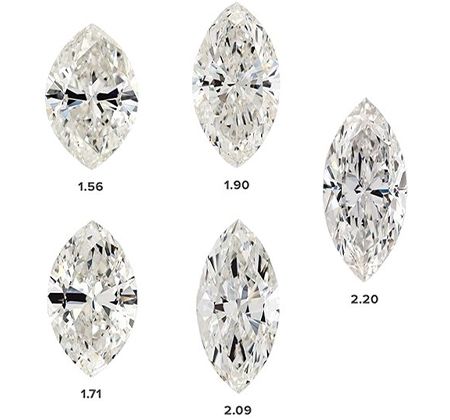
BUYER'S GUIDE TO MARQUISE CUT DIAMONDS

Whether or not the story about Louis XV and his mistress is true, the marquise cut is part of the revolution in diamond cutting in the eighteenth century, as better equipment allowed cutters to experiment with adding more facets to a wide range of brilliant cuts.
The marquise cut suited the decorative taste at the time and represented innovation. In Britain, the shape’s nautical shape found favor with the Edwardians. Sailing was a popular pastime for King Edward VII.
In America, the marquise was particularly popular in the 1950s and again in the 1970s. Jacqueline Kennedy received one from Aristotle Onassis.
Marquise Shape Diamond Quality Checklist

Here’s what you need to know about shopping for marquise diamonds. The basics of the 4Cs are the same as for round brilliant diamonds but the GIA grading reports for marquise diamonds don’t include a cut grade. That means any cut grade you see on a retailer’s website is more about marketing than science.
Because marquise cut diamonds are less common than round brilliants, many retailers won’t have any in stock. You are much better off buying fancy shapes like this online because you’ll have a much better selection in your target color, clarity and carat weight. This really helps you compare the shapes and cut qualities and pick a really beautiful diamond that’s a good value too.
It’s important to rely only on diamond grading reports from GIA or AGS, the world’s most respected diamond grading laboratories. You can’t rely on the grades from other labs to be equivalent.

about marquise-cut diamonds is that
they are relatively shallow.
Why? That means that they look larger than almost any other diamond shape. Just look at a comparison of rings set with 1.25-carat diamonds in six different shapes.
See how big the marquise looks in comparison to the round brilliant? It’s as if your diamond magically grew 20 percent in size!
And there’s one more thing we love about marquise shape diamonds. They are 30-40 percent cheaper than round brilliant diamonds of the same size and quality. So they look bigger and they cost less? How could you not love marquise cut diamonds?

vs Pear Shaped Diamond

The two diamond shapes that are most similar to a marquise cut are the oval diamond and the pear shaped diamond.
The oval shape diamond is much more classic and traditional than the marquise cut. It has a similar elongated silhouette and shallow depth so it also looks relatively large on your finger. It is more subtle than the marquise.
Pear shaped diamonds are as unconventional as the marquise cut, with the added drama of asymmetry.
All three are much larger in appearance than the round brilliant and less per carat for the same
quality. The marquise cut is the most affordable
of the three.
Marquise cut diamond engagement rings are famously flattering to your fingers, making them look long and slim.

Our customers’ favorite setting for marquise engagement rings is an elegant marquise diamond solitaire with a pave band. If you prefer a classic look, a marquise halo engagement ring has extra diamonds and extra sparkle. Because the marquise cut also lends itself to sleek modern engagement ring styles, a simple bezel-set marquise solitaire engagement ring appeals to many minimalist brides. Three stone marquise engagement rings most often have tapered baguettes on the sides. Looking for something more unique? Try setting a marquise shape diamond east-west across the finger for a twist on a classic. No matter which way you set your marquise make sure those points are protected by the setting. Any prong setting needs v-shaped prongs over the points.
With all the variables to consider, buying a marquise-shape diamond can be challenging. That’s why we created ROSI, an artificial intelligence personal shopping tool powered by IBM’s Watson: to sort through all the Marquise cut diamonds available on the market to find the best balance of quality and value for your budget. See the best marquise shaped diamond for your budget.
ROSI generally recommends a color of H for a marquise shape diamond: J and lower colors will start to show noticeable color near the points of the marquise. Clarity should be at least VS2.
A ratio of 1.5 would be fatter and a ratio of 2.5 would be skinnier. Which you like best is a matter of personal taste but most people prefer something in the middle.

No matter which shape appeals to you most, there is one important factor to consider in the cut. Almost every marquise cut diamond has an optical effect called the “bow tie”: a dark pattern of light across the center of the diamond. It’s usually the reflection of your head (or the camera in photographs.) The effect can be really obvious in some diamonds and less so in others.
Although your marquise shaped diamond will have a bow-tie in some form, it’s important to choose a marquise that sparkles with brilliance across the whole diamond, even in the bow tie area.




























